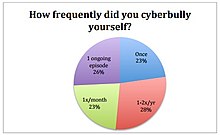
Auto-trolling, self-cyberbullying, digital Munchausen or digital self-harm is a form of self-abuse on the Internet. It is usually done by teenagers posting fake insults on social media, attacking themselves to elicit attention and sympathy. A study in 2012 found that about 35 per cent of those who did this felt better. Studies in 2016 and 2019 found an increase in prevalence in American adolescents rising from 6 to 9 per cent. In a 2011 study, boys were more likely than girls to admit to digital self-bullying. In a 2022 study published by researchers Justin Patchin, Sameer Hinduja, and Ryan Meldrum, US youth who engaged in digital self-harm were between five and seven times more likely to have considered suicide and between nine and fifteen times more likely to have attempted suicide.
In the UK, a woman was cautioned in 2009 for trolling herself on Facebook and then jailed for 20 months for repeat offences during 2011–12.
Though digital self-harm can be done in various ways, it is usually done in a public or semi-public setting. Researchers Rinjani Soengkoeng and Ahmed Moustafa suggest that there are three types of digital self-harm. These are:
- social development (either determine if one's friends would defend them or prove one's resilience)
- personal gain (sympathy or entertainment)
- manifestation of negative emotions (which can derive from mental health issues,stressors, or social rejection).
These appear to be common reasons for digital self harm according to Sameer Hinduja and Justin W. Patchin's 2017 study of American middle and high school students.
Contributing factors
Common correlations to digital self-harm include bullying, depression, negative emotionality, and sleep deprivation. There is also research that suggests digital self-harm and physical self-harm have similar causes and motivations. The two seem to be positively associated with physical self-harm and suicidal thoughts and behaviors.
Prevention
Identifying and preventing digital self-harm is arguably more difficult than its offline counterpart. For one, it is hard for parents to monitor their child's online presence. Taking away internet access completely is usually impractical, as the internet is important for gaining important information from the outside world. There is a need to create strategies for digital self-harm prevention, as it is not the same as physical self harm or suicide. Due to anonymous apps such as Yik Yak, Whisper, and Secret, it is more difficult to track digital self-harm without possible invasion of privacy. Research by Dr. Sujita Kumar Kar suggests that "calling out" the behavior of digital-self harm may be counterproductive. Instead, encouragement to change online behavior may more beneficial in the long term.
References
- ^ Englander, Elizabeth (June 2012), Digital Self-Harm: Frequency, Type, Motivations, and Outcomes (PDF), Massachusetts Aggression Reduction Center
- ^ Ktena, Natalie (2018-05-16). "These teens secretly trolled themselves online". BBC Three. Retrieved 2020-01-23.
- ^ "Why more young Americans are cyber-bullying themselves", The Economist, 11 January 2020
- Juli Fraga (21 April 2018), When Teens Cyberbully Themselves, NPR
- Patchin, Justin; Hinduja, Sameer (2017), "Digital Self-Harm Among Adolescents", Journal of Adolescent Health, 61 (6): 761–766, doi:10.1016/j.jadohealth.2017.06.012, PMID 28935385, S2CID 3650036
- Ken Corish (2014), "Waving Silently - Technology and Self-harm", Every Child Journal, Imaginative Minds Group, archived from the original on 2023-02-09, retrieved 2020-07-21
- Fairbank, Rachel (6 September 2022). "What Parents Need to Know About 'Digital Self-Harm'". LifeHacker.
- Maria Tadeo (5 February 2014), "Woman becomes first person to be jailed for 'trolling herself'", The Independent
- ^ Ramluggun, Pras; Small, Myra (6 January 2022). "Understanding digital self-harm and its implications for mental health practice". Mental Health Practice. 25 (1). RCN Publishing Company. doi:10.7748/mhp.2021.e1592 (inactive 1 November 2024). ISSN 1465-8720.
{{cite journal}}: CS1 maint: DOI inactive as of November 2024 (link) - ^ Soengkoeng, Rinjani; Moustafa, Ahmed A. (9 March 2022). "Digital self-harm: an examination of the current literature with recommendations for future research". Discover Psychology. 2 (1): 19. doi:10.1007/s44202-022-00032-8. ISSN 2731-4537. S2CID 247381023.
- Patchin, Justin W.; Hinduja, Sameer (December 2017). "Digital Self-Harm Among Adolescents". Journal of Adolescent Health. 61 (6). Elsevier: 761–766. doi:10.1016/j.jadohealth.2017.06.012. ISSN 1054-139X. PMID 28935385. S2CID 3650036. ProQuest 1970948534.
- Cyberbullying Prevention and Response: Expert Perspectives. New York: Routledge. 23 June 2011.
- ^ Pacheco, Edgar; Melhuish, Neil; Fiske, Jandy (1 May 2019), Digital Self-Harm: Prevalence, Motivations and Outcomes for Teens Who Cyberbully Themselves, Rochester, NY, doi:10.2139/ssrn.3374725, S2CID 197744883, SSRN 3374725
{{citation}}: CS1 maint: location missing publisher (link) - Meldrum, Ryan C.; Patchin, Justin W.; Young, Jacob T.N.; Hinduja, Sameer (4 March 2022). "Bullying Victimization, Negative Emotions, and Digital Self-Harm: Testing a Theoretical Model of Indirect Effects". Deviant Behavior. 43 (3): 303–321. doi:10.1080/01639625.2020.1833380. ISSN 0163-9625. S2CID 225133032.
- ^ Semenza, Daniel C.; Meldrum, Ryan C.; Testa, Alexander; Jackson, Dylan B. (May 2022). "Sleep duration, depressive symptoms, and digital self-harm among adolescents". Child & Adolescent Mental Health. 27 (2). Wiley Blackwell: 103–110. doi:10.1111/camh.12457. ISSN 1475-357X. PMID 33763977. S2CID 232354527.
- Erreygers, Sara; Symons, Michelle; Vandebosch, Heidi; Pabian, Sara (1 January 2022). "Fictitious online victimization: Exploration and creation of a measurement instrument". New Media & Society. 24 (1): 156–177. doi:10.1177/1461444820960079. hdl:10067/1716470151162165141. ISSN 1461-4448. S2CID 225000344.
- "Suicide prevention for physicians: identification, intervention and mitigation of risk". Journal of Indian Association for Child and Adolescent Mental Health. 2021.
- Franklin, Joseph C.; Ribeiro, Jessica D.; Fox, Kathryn R.; Bentley, Kate H.; Kleiman, Evan M.; Huang, Xieyining; Musacchio, Katherine M.; Jaroszewski, Adam C.; Chang, Bernard P.; Nock, Matthew K. (2017). "Risk factors for suicidal thoughts and behaviors: A meta-analysis of 50 years of research". Psychological Bulletin. 143 (2): 187–232. doi:10.1037/bul0000084. ISSN 1939-1455. PMID 27841450. S2CID 3941854.
- ^ Kar, Sujita Kumar; Arafat, S. M. Yasir (January 2021). "Digital self-harm in adolescents: Strategies of Prevention". Journal of Indian Association for Child & Adolescent Mental Health. 17 (1): 137–141. doi:10.1177/0973134220210110. ISSN 0973-1342. S2CID 250992997.